Exceptionally well-built with a wide range of adjustability and compatibility, the Alta Racks vertical bike rack is the ultimate do-it-all bike rack. The Swiss army knife of racks, the Alta can hold just about any size and style of bike on just about any vehicle with a Class III hitch, including RVs.
Got a 20″ fat-tire ebike, a 24″ kids bike, and a 29″ downhill rig to haul? No problem. Swing-out doors on a van, a rear-mounted spare on your Jeep, or need space to drop a tailgate on a truck? Alta’s got you covered. If that wasn’t enough, conversion kits are also available to carry skis, snowboards, and even cargo boxes!
So whether you need a bomb-proof rack for hitting up remote single-track, a highly adaptable rack for a wide range of bikes, a high capacity rack with a swing arm, or a sturdy, bounce-free rack for your RV, the Alta rack system is designed for all of these things.
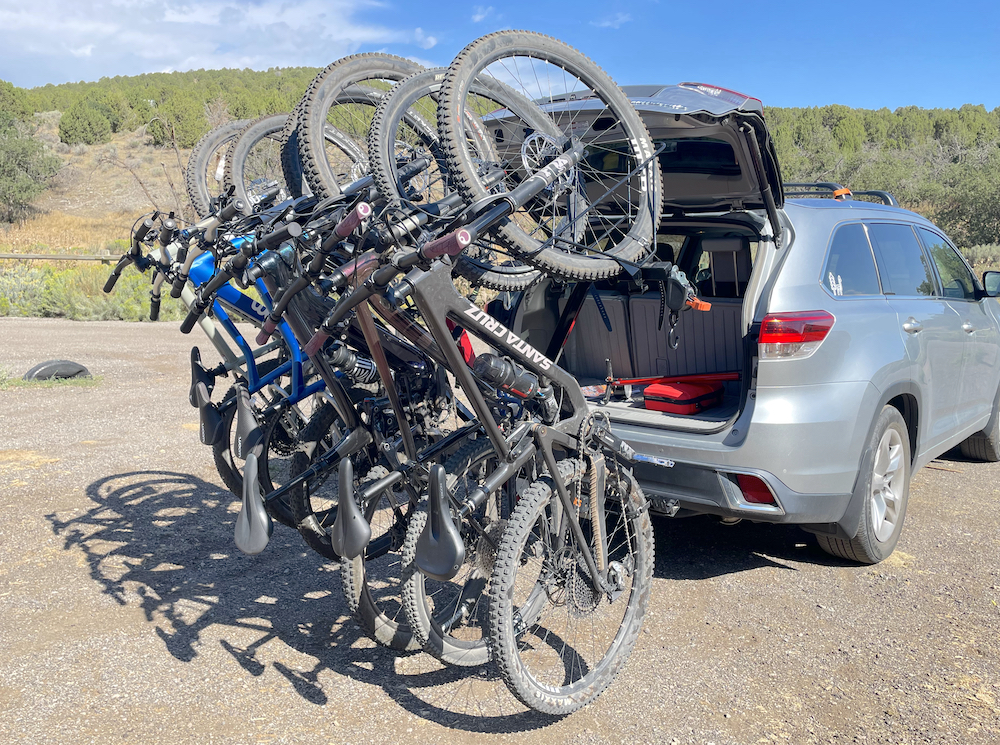
We also put the Alta to the test to see how it compares to the popular Velocirax vertical rack. We tested everything from ease of loading to clearance issues and how the rack “feels” while driving. In this comprehensive review, we’ll cover everything you need to know about the Alta so you can confidently decide if it’s the best bike rack for you!
Alta Rack Overview

RATING: Exceptional
MSRP:$853+, $1,279 as shown for 6 capacity
BEST FOR: Carrying a wide variety of bike styles and sizes. Especially beneficial for vehicles with uni-body frames (smaller SUVs, minivans, etc), RVs, high or low-hitch vehicles, as well as trucks (allows tailgate to fold down flat).
FITS WHEEL SIZES: 20″ to 29″, including fat bikes (20″ to 27.5″), mid-fat bikes, and road bikes. Not compatible with 16″ bikes or smaller.
CAPACITY: 3 to 6 (7 possible on Superior models)
RACK STYLE: Vertical with optional Swing-out arm
HITCH SIZE: 2″ Class III, 500 lb. receivers only
PROS:
- Exceptionally well-built with clean, quality welds
- Made in the USA!
- Tilts to allow for easier loading and unloading, especially with heavier ebikes
- Truck tailgates can fully lower and rear hatches open completely when rack is tilted
- Highest weight capacity of any rack – 300 lb. for Alta, 350 lb. for Alta Superior Model
- Fits a wide range of wheel sizes, everything from 20″ kids’ bikes to all sizes of fat bikes
- Tow arm angles up from hitch to provide plenty of ground clearance when not loaded
- Entire rack is height adjustable to accommodate vehicles with low or high hitches
- Space between wheel trays is adjustable
- Easy-to-use Voile tie-down wheel straps
- Green footprint – entire Alta production and distribution is within a 10-mile radius
- Suitable for RVs when used with retractable side straps
- Retractable side straps greatly help to prevent vehicle flexing and improve handling (especially with uni-body frames)
- The only high-capacity rack fully compatible with a swing-out arm.
CONS:
- High cost compared to other racks
- No built-in bike locking mechanism – but includes loops for use with cable lock
- No internal anti-wobble system (comes with an internal stabilizer and an optional external kit for an additional cost)
QUICK NOTE: If this review helps you out and you decide to purchase an Alta Rack, we would greatly appreciate it if you added our name “Two Wheeling Tots” in the notes section at checkout. We are not an affiliate of Alta and receive no monetary benefits from your purchase, but it would help us continue to share the love of Alta with others.
For the sake of transparency, Alta did provide their Superior (DaSanchez) kit upgrade and their Swinger kit to help us facilitate this updated review, but the rack shown in this review was purchased by us.
Alta Racks Video Review
Check out the Alta Rack in action in our video review below. We’ll show you all of its unique features and provide visual comparisons with Velocirax.
**NOTE: This video was filmed in 2021, so it is a bit out of date. Here are some notable updates missing in this video:
- Alta now has a “Superior” line of racks that can hold up to 7 bikes, with no ebike limit within the rack’s 350 lb. weight capacity.
- Velocirax’s updated small wheel basket fits 20″ bikes without any issues
- Both Alta’s and Velocirax basket for 20″ bikes can fit 16″ bikes when the baskets are padded with a pool noodle. Neither is a perfect fit, but both work in a pinch
Alta Racks Vertical Bike Rack – Results of our Tests
Originally purchased in May of 2021, our family of 5 has been using our Alta Racks 6 capacity rack for over three years now, and we continue to be impressed by its durability, adjustability, and ease of use. We’ve safely hauled kids’ bikes, e-bikes, and fat-bikes while traversing everything from concrete jungles to rough fire roads.
In August of 2022 we converted our Alta Rack to their new “Superior” model and have since updated this review to discuss the differences between Alta’s two lines of racks. In March of 2024, we also added Alta’s swing-out arm to our rack, which we review later in the article.
ALTA RACKS REVIEW OUTLINE
- 30-Second Review Summary
- Who are we and why trust us?
- How does the Alta Rack work?
- Alta GPR (standard original model) vs. Superior (new upgraded model)
- Standout and Unique Features of the Alta Rack
- Alta Racks vs. Velocirax Features
- Alta’s Swing-Out Arm
- Benefits of Vertical Racks over Platform Racks
- Alta Racks Bottom Line
30-Second Review Summary – (for you TL;DR folks)
After a year of use, here are four main reasons why we would absolutely buy the Alta again over another vertical rack. While other vertical racks, like the Velocirax and Yakima HangTight, also do a phenomenal job at carrying bikes (and for a lower price!), we personally found these four points to be worth the extra expense of the Alta. We will expound on these four reasons as well as additional benefits of the Alta further down in the review.
(1) High Ground Clearance – The upward angle of the Alta’s hitch arm provides plenty of ground clearance, so you never have to worry about bottoming out – even on the steepest driveways, tallest speed bumps, or the roughest fire roads. This is especially beneficial on lower-hitch vehicles (like a minivan or mid-size SUV).
(2) Adjustable height for easy loading on high-hitch vehicles – The top bar of the Alta can be lowered, which makes the rack easier to load on high hitch vehicles (trucks, SUVs with lifts) without the use of a drop hitch receiver.
(3) Quickly adapts to fit a wide range of wheel sizes – Configuring the Alta to fit your specific combinations of bikes is quick and easy. The individual wheel baskets for the front tire slide on and off the Alta in seconds – without the need for any tools. As a result, I can easily do a shuttle run with six 29ers in the morning and then swap out a few standard baskets (which fit 24″ to 29″) for a couple 20″ wheel baskets to take the little ones out in the afternoon.
(4) Retractable straps are a game changer – Alta racks come with optional side straps that run between the two ends of the top bar of the rack and the crossbars on your car’s roof. The side straps allow for two additional points of contact between the rack and the car, which allows the rack to always move with the car and never against it. While seemingly minor, the straps make a big difference in how the rack feels behind the car when traveling freeway speeds or on bumpy fire roads with a fully loaded rack.
The issue is NOT the rack bouncing within the hitch receiver (the rack is solid and doesn’t budge), but rather the car itself flexing under the dead weight of the rack. This is especially prevalent on cars with unibody frames. Alta is the only rack that offers multiple contact points to ensure the rack always moves with the car, and never against.

Who are we and why trust us?
Here at Two Wheeling Tots, our team has been testing out kids’ bike products since 2009. We have tested over 400 kids bikes and regularly haul kids’ bikes (as well as our own adult bikes) around town. As a result, we have used (and reviewed) over 20 different car bike racks and have experienced our fair share of challenges.
As avid mountain bikers ourselves, we also understand the importance of making sure our precious rigs arrive at the trailhead unscathed. Whether down a rough fire road or just around the corner, our idea of a quality rack is one that doesn’t cause you to constantly look out the rear view mirror to make sure everything’s okay.
Prior to purchasing our Alta, we were able to do a test run for a few weeks. After our demo period was over, we quickly realized how much easier it was to use than our beloved Thule T2 platform rack. So we went back to Alta and bought their 6-capacity rack (and yes, at full price).
Before making that investment, we did a lot of research to make sure Alta was the best rack for our family. Being one of the most expensive vertical hitch racks on the market, we wanted to make sure the benefits of the Alta Rack were worth its upgraded price.
Prior to writing this review we also had the chance to extensively test out the comparable and more affordable Velocirax 6 capacity vertical rack. All in all, both racks are great, but I’ll focus this review on why we felt the Alta Rack was worth the additional expense for our family.
For some, the benefits of the Alta may not be worth the added expense, but after reading this review, we hope you’ll be able to confidently decide.
How do Alta Racks work?
Before we dive into the details of the Alta Rack, let’s briefly go over how the Alta Rack works (more in-depth info below). Like all vertical racks, Alta Racks are only suitable on cars with a Class III 2″ hitch.
Alta transports bikes vertically, with the front tire pointing up above the car and the bottom tire pointing down towards the ground. The bikes have the front wheel resting in a wheel basket that is mounted to a horizontal top bar. The rear wheel rests against a lower horizontal bar.

Alta offers 4 different size wheel baskets, with the standard basket (holds 24″ – 29″ wheels) being the most common (other baskets are for 20″ and fat tire bikes). Each wheel basket slides on the top bar via its square mounting bracket and is secured in place via a screw knob. Loosening the screw knob also allows the individual wheel basket to slide left to right along the top bar to adjust space between bikes when needed.

To ease in loading or unloading, the Alta rack can be tilted down to allow the baskets to be lowered. To lower the rack, the orange outer safety pin at the base of the rack must first be removed.

Once removed, rotating the black lever on the rear of the rack will release the rack and allow it to lower until it meets the black rubber stopper (shown above). Especially when loaded, the rack can lower very quickly, so it is best to support the rack while lowering.

In the tilted position, bikes are loaded by placing the front wheel into the individual wheel baskets. When loading the Alta, it is best to load the bikes from largest to smallest, going right to left on the car. The front and rear wheels of each bike are then held in place with two rubber Voile straps.
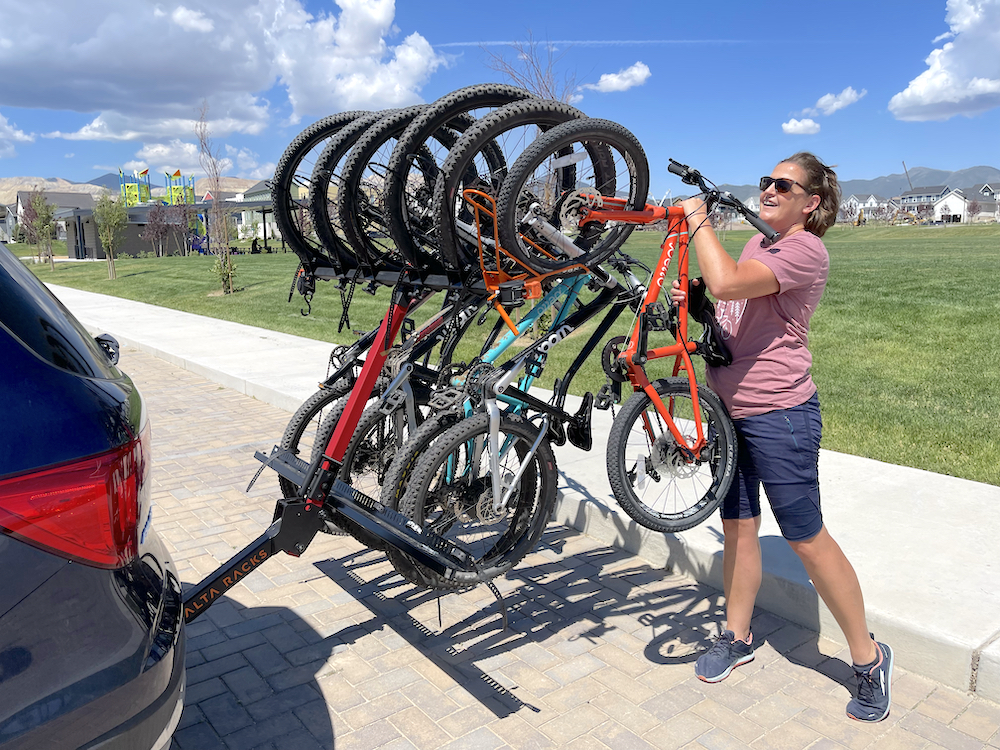
Once fully loaded (or unloaded), the process is reversed to raise the rack. First, ensure the black lever is pointed back to the right, and then push up the rack via the center mast or via one of the baskets. When the mast is upright, the rack will automatically lock into place. For added security, always re-insert the orange safety pin before driving.

If desired, the retractable, ratcheting side support straps can then be attached to the car’s crossbars.
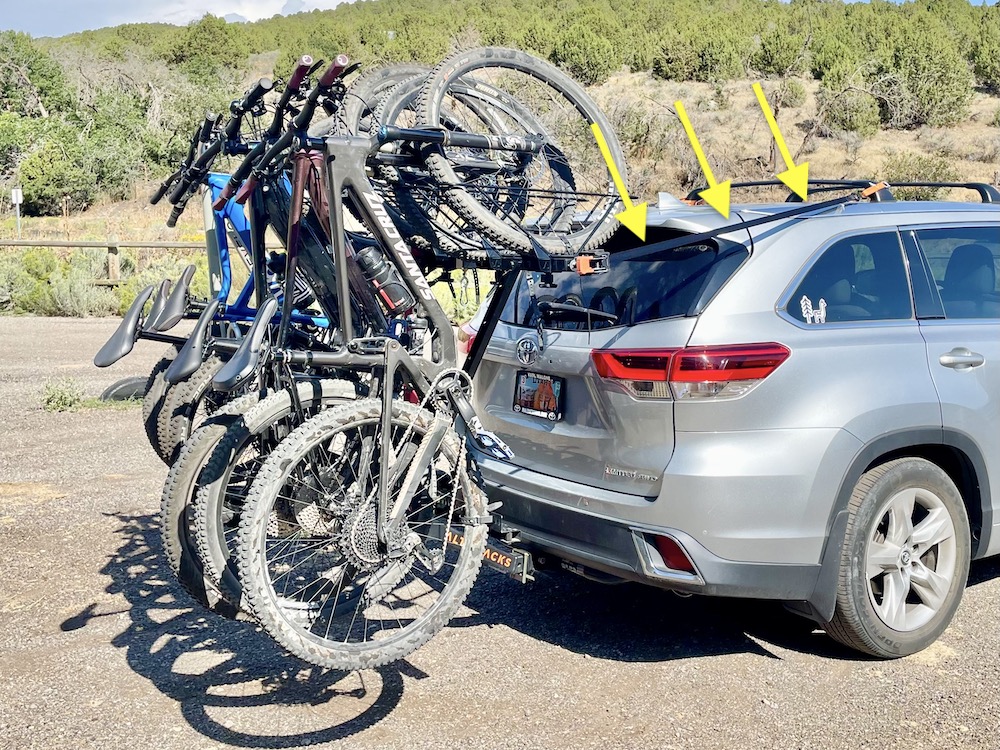
Alta GPR (standard – original rack) vs. Superior (new upgraded rack)
Alta now offers two lines of racks – the original (known as either “Alta” or GPR – General Purpose Rack) and the Superior. The racks are identical, except for the Superior’s angled side supports and longer top bar.

The angled side supports of the Superior allow it to hold even heavier loads than the standard Alta GPR rack. While the Alta GPR can hold up to 300 lb. (with a 2 ebike max) the Superior can hold 350 lb. with no ebike limit within the 350 lb. limit. The longer top bar also allows for more space between bikes, as well as allowing for extra room to add a seventh basket.
Both the Alta and the Superior are compatible with all of Alta’s different wheels size baskets. Both racks are available in 3 to 6 capacity. The largest Superior model (known as the “Superior DeSanchez”), is the only Alta model that can hold 7 bikes.
| Alta | Alta Superior | |
|---|---|---|
| MSRP | $853 – $1,279 | $1,485 – $1,750 |
| Bike Capacity | 1 to 6 | 1 to 7 |
| Ebike Capacity | 2 | up to 7 |
| Total Weight Capacity | 300 lb. | 350 lb. |
| Max Weight Per Bike | 50 lb. | 60 lb. |
The “Superior” model is also available as an upgrade kit if you already have the standard Alta rack. The upgrade kit contains the angled black side supports as well as a 6″ longer top and bottom bar. The hitch arm, main mast, wheel baskets, and straps are the same on both racks and are designed to be reused if you upgrade.
Unique Features of Alta Racks
While all vertical racks work in basically the same way (some mount the bikes via the handlebar or the crown of the bike’s fork instead of the wheel), Alta Racks do have several unique features not found on other vertical racks (that we know of).
This list contains all the unique features of the Alta that are not available on other vertical bike racks. Some items on this list may not be a big deal for your needs, while others may be game-changers. That’s the beauty of the Alta – it is very customizable and can accommodate a wide range of uses and preferences.
Wide Range of Adjustability
Alta Racks does a great job at accommodating just about any bike wheel and tire size with zero frame-to-rack (or fork-to-rack) contact. Beyond that, the rack is easily adjustable to allow you to haul a wide range of bike combinations on the same rack.
- Tool-free, swappable wheel baskets – you can choose any combination of FIVE different wheel size baskets for your rack:
(1) standard basket (fits 24″ to 29″)
(2) 20″ bike basket (also fits 16″ when padded with a pool noodle – not perfect, but it works)
(3) 20″ fat-tire basket (for bikes like RadPower or Super73)
(4) mid-fat bikes (2.9″ to 3.8″)
(5) fat-tire bikes (3.9″ – 5.8″)
These baskets can easily be swapped out within minutes without tools. (Some baskets require tools to remove with Alta’s Superior line) - Adjustable spacing between bikes – All baskets can slide left or right to allow for minor or major spacing adjustments.
- Changing bike capacity – Alta’s standard rack can hold 4, 5, or 6 bikes. The only thing that changes is the number of baskets on the top bar. You can buy the baskets at any time, so there is no need to buy a larger rack “just in case”. If you later find you need to haul 6 bikes instead of 4, just buy 2 more baskets. Alta also sells a smaller “Three Pack” rack that holds up to 3 bikes and the “Superior” that can hold up to 7.
- Highest weight capacity – 300 lb. (50 lb. per bike) on all sizes of the Alta GPR racks (limit 2 ebikes). The upgraded Superior model can hold 350 lb. total (60 lb. per bike) with no ebike limit.

Ease of Use
We love Alta because it’s easy to use when fully loaded, but also a breeze to use when not carrying bikes. Considering our bike racks are almost always on the car, but only a very small percentage of that time is actually fully loaded with bikes, ease of use when not loaded is almost just as important.
- Angled hitch arm – a life-saver for additional clearance, whether loaded or not!
- Quickly tilts down for rear access – Alta quickly and easily tilts down when unloaded as well as loaded. Most racks can tilt down, but often take more time or effort than the Alta.
- Voile tire straps – Easy to use, easy to replace, and can even be used to strap a tube or water bottle to your bike in a pinch

Fits Well on Wide Range of Vehicles
The Alta Rack fits a wide range of vehicles as is. No need for hitch extenders or adaptors. If it doesn’t work with your vehicle, the team at Alta will work with you to find a solution.
- Height-adjustable top bar – Raising or lowering the top bar allows you to raise or lower the wheel baskets. This is a huge benefit for taller vehicles or trucks/SUVs with lifts!
- Easy tailgate access – The rack does not prevent the tailgate from completely lowering on most trucks.
- Side stability straps – Adds multiple points of contact to ensure the rack always moves with the car and never against.
- Suitable for RVs – Side straps allow for additional contact points to allow for use on RVs with Class III hitches
- Plenty of room for rear-mounted spares – No clearance issues on Jeeps or off-road vehicles with spares.
- Optional Swing-out arm: Alta’s Swinger allows a fully loaded Alta to swing out and away from the rear of the car. Perfect for vans with split rear doors, SUVs with side swing tailgates, or for anyone who wants easier access to the rear of their car.

Tons of Accessories
More than just a bike rack, conversion kits are also available to broaden the functionality of the Alta. Here is a small sample of what is available.
- Mobile Floor Stand – Converts rack into a mobile garage bike storage unit
- Winter Kit – Metal supports to allow ski and snowboard racks to be mounted
- Bike Work Stand – Easily work on your bike at any trailhead
- Gear Hanger – Hang your helmet or hydration pack on the rack and up and out of the dirt

General Awesomeness
While not affecting the usability of the racks, we love supporting great companies who stand behind their products. The main reason an Alta Rack costs more is due to their commitment to keeping manufacturing in the US.
- Made in the USA with exceptional quality (Lolo Racks is an exception and is also made in the USA)
- Green footprint – Alta’s entire production, from manufacturing to shipping, is within a 10-mile radius
- Lifetime warranty to the original purchaser – most other racks are only 2 years!
- Available in LOTS of different colors – color is just the main mast, not the bars or baskets
Quick Note: To be fair, while we have seen and admired the Lolo, North Shore, and Recon racks at the trailhead, we have not had the chance to extensively test them out like we have Alta and Velocirax. We have, however, tested out the Yakima Hangtight (link to our review). Based on our online research, however, the features outlined above are unique to Alta, but please correct us in the comments below if we are wrong.
Alta Racks vs. Velocirax Features
All vertical racks, including the Alta and the Velocirax, share tons of great features, including increased bike capacity and rear brake light visibility. You can learn more about those in our Benefits of Vertical Bike Racks section later in our review.
In this section, we’ll specifically cover the differences between the Alta and the Velocirax. We focused on these two as they are the most similar of the widely available “basket based” vertical bike racks on the market. While the degree of importance of these will vary from person to person, I roughly ordered them based on what I found to be the most important differences to the least.
Hitch Arm Clearance
The base of the Alta rack is unique in that it bends upwards before the pivot point of the main mast. This bend allows for several additional inches of clearance when unloaded as compared to other vertical racks, including Velocirax.
When loaded, the clearance between the two racks is actually quite similar (the rear tires on the bikes hang down to similar heights on both racks), but when unloaded, the Alta was the clear winner.

While the unloaded clearance may seem minor, it quickly became a major point of differentiation every time I came across an unexpected dip or steep elevation changes around town. During our test period, we bottomed out with the Velocirax a few times, but never had an issue with the Alta. (FYI the hitch height of these cars were both around 15″)
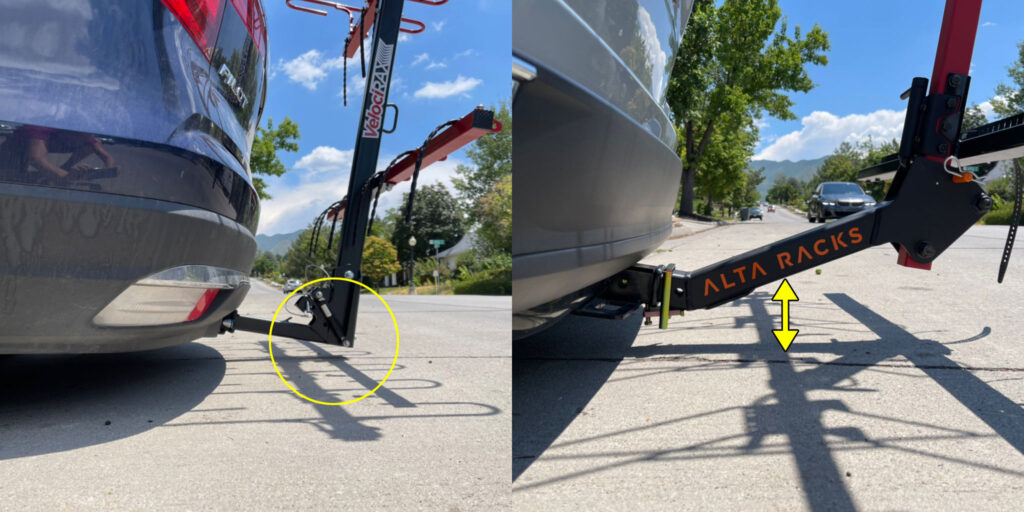
Weight Distribution of Racks
When driving with a fully-loaded 6-capacity Velocirax and Alta hitched to our cars, we found the Alta to be less noticeable than the Velocirax. While it wasn’t a huge difference, it was just more noticeable, especially on unexpected dips and over uneven surfaces. When driving with the Alta, you could still feel it when going over bumps and big dips, but over time you could forget it was there.
While there are certainly a lot of factors at play, the position of the racks in relation to the car likely plays a role. Looking at the racks while fully loaded, the Velocirax always seemed to lean away from our car, while the Alta remained more straight up and down. Tilting away from the car would increase the leverage the rack has on the hitch, which could increase the amount of force the rack applies to the car.
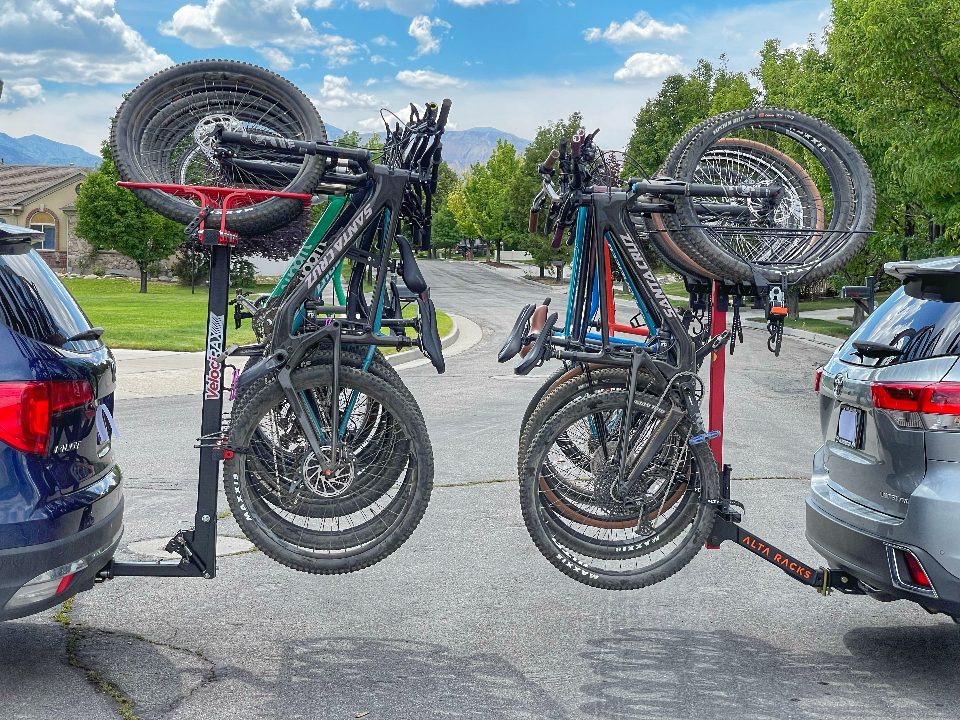
With 200 lb. to 300 lb. on the rack, bike racks can also “bounce” or sway along with the rear end of the car, especially when traveling at higher freeway speeds or when going over bumps or dips in the road. As a secondary measure (primary being hitch with hitch stabilizer), Alta also offers retractable side straps ($69 for a set) that attach to a car’s roof rails. These straps provide two additional points of contact to ensure the rack always moves with the car and not against it.
While at first we didn’t bother to use them, once we did, we were shocked at how much of a difference they made. When attached, the Alta was even less noticeable and seem to always be in sync with the car.

The difference with the retractable straps was even more noticeable on unibody vehicles (small SUVs, minivans) than with frame-on-body vehicles (trucks, large SUVs). Since unibody vehicles are much more likely to be affected by forces directed through the hitch, they have even more to benefit from using the straps.
To be clear, the movement the straps is minimizing is not from the Alta moving within the hitch. When properly installed and tightened, the rack is solid and does not shift within the hitch. With the straps connected to the roof rails, it is preventing the rack from flexing in an opposite direction on the unibody frame.
The straps are an upgrade, but are absolutely worth the purchase! Each strap has a breaking load of over 1,000 pounds, so they are sure to keep the Alta steady, even under the toughest conditions. These straps are what also allows the rack to be compatible with RVs.

If you don’t order your rack with retractable straps, end caps with a loop for a rope (or anything else) are included.

Height Adjustability
Another unique feature of the Alta Rack is the ability to lower or raise the upper horizontal bar of the rack. With 3 different mounting positions, the vertical position of all the bikes (the entire top bar – not individual bikes) can be raised or lowered about 6 inches.
This helps the rack to easily adjust to fit low or high clearance vehicles. On cars that sit lower to the ground, the top bar can be set to the highest position to provide more clearance for the rear wheel of the bikes against the ground.
On high clearance vehicles, in which the hitch is already high off the ground, the top bar can be placed in the lowest position to lower the wheel baskets to help aid in loading and unloading bikes on a tall vehicle.
In the picture below, you can see the top bar is in the middle position on a Toyota Highlander on the left, but is in the lowest position on the raised Land Cruiser on the right.

The Velocirax cannot adjust the height. As a result, the taller your hitch, the taller the rack gets on your car. When loaded on a Toyota Land Cruiser, the Velocirax was ridiculously tall, which made it almost impossible to use. Even when the Velocirax was tilted down, loading bikes was quite a task on our Land Cruiser. There was no way to “roll” up the bikes as shown in their videos. (As a point of reference, the boy in the picture is 5’8″ and the bike he is trying to load is a women’s large framed bike.)

Once loaded, however, the real challenge came when trying to push the rack back up. Being 5’10”, I could push the loaded Alta up by myself on both the Highlander and the Land Cruiser. With the Velocirax, I could push it up by myself when mounted on our Highlander, but I could not come close to getting the Velocirax up on the higher Land Cruiser.
With the help of my tall 12 and 14-year-old kids, the three of us could barely get the Velocirax up on the Land Cruiser. The main problem wasn’t the weight (I could push the rack up on other cars), it was the height. Getting the main mast upward enough to lock into place requires you to push UP, not just forward.
For reference, the hitch height on this Land Cruiser is 25.5″ versus 15.25″ on the Highlander. We also tested the Velocirax on a Ford Expedition with a 20.5″ and as expected, it was much easier than the Land Cruiser, but still not as easy as the Alta.

To solve this problem, Velocirax now offers a hitch adapter that drops the rack 3.5″. While the adapter doesn’t allow the rack to drop as low as the Alta, it significantly helps when loading and unloading the Velocirax.
The same hitch adapter, however, also extends the rack out 4″ away from the receiver. The additional space allows tailgates to be fully loaded when the rack is mounted (Alta does this without a receiver), but it also increases the leverage the rack has on the hitch receiver.
Spacing and Capacity Flexibility of the Alta
A major difference between the Velocirax and the Alta is how their baskets mount to the rack. Alta’s baskets slide onto the top bar while the Velocirax’s bolt on.

In addition to being able to quickly swap baskets, Alta’s design allows the baskets to be moved from left to right to adjust the spacing between the bikes. We found this to be especially beneficial when the bikes we’re loading are various sizes and styles, especially with road bikes and kids bikes. If you’re always carrying the same combination of bikes though, you only have to adjust the spacing once and this feature won’t be as important to you.

The ability to add, remove, as well as reposition Alta’s baskets on the rack allows for more flexibility in capacity and spacing. With every basket that is added, removed, or swapped, the spacing between the baskets can easily be adjusted. As a result, you can just as easily evenly space 5 fat bikes on the rack as you can 5 kids bikes or road bikes.
In fact, Alta 4, 5, and 6 racks are exactly the same, except for the number of baskets it comes with. So if you want to convert your Alta 4 into an Alta 6, you just need to buy 2 more baskets. With every basket added, the space between each basket gets closer, but unlike every other vertical bike rack on the market, the same rack can evenly space 4, 5 or 6 bikes.
Loading Bikes
Loading bikes onto the Alta and the Velocirax are very similar. While there are some notable differences, all in all, how the bikes load shouldn’t be a major selling point. Between the two, we did find the Velocirax is easier to load, but not significantly so.
Both racks are to be loaded starting with the largest bikes and ending with the smallest. While this mainly applies to wheel size, it can also apply to the stack height of the bikes. The “tallest” bike with the highest placed handlebars should be loaded first, while the bike with the shortest stack is added last. This can help to eliminate contact between handlebars and frames, but not always.
Due to the tilt direction of their wheel baskets, the Alta loads from the left to the right side, while the Velocirax from right to left.
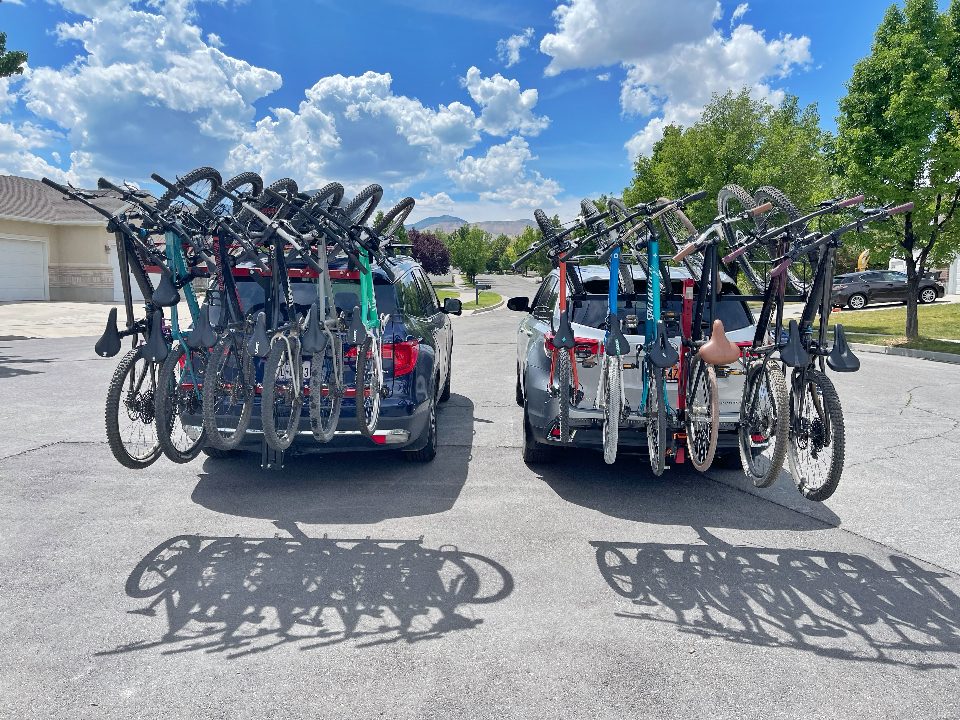
Sometimes in order to prevent contact between bikes on both racks, the order needs to be switched up a bit. Issues with spacing on both racks were much more common with 20″ to 26″ bikes than with larger adult mountain bikes.
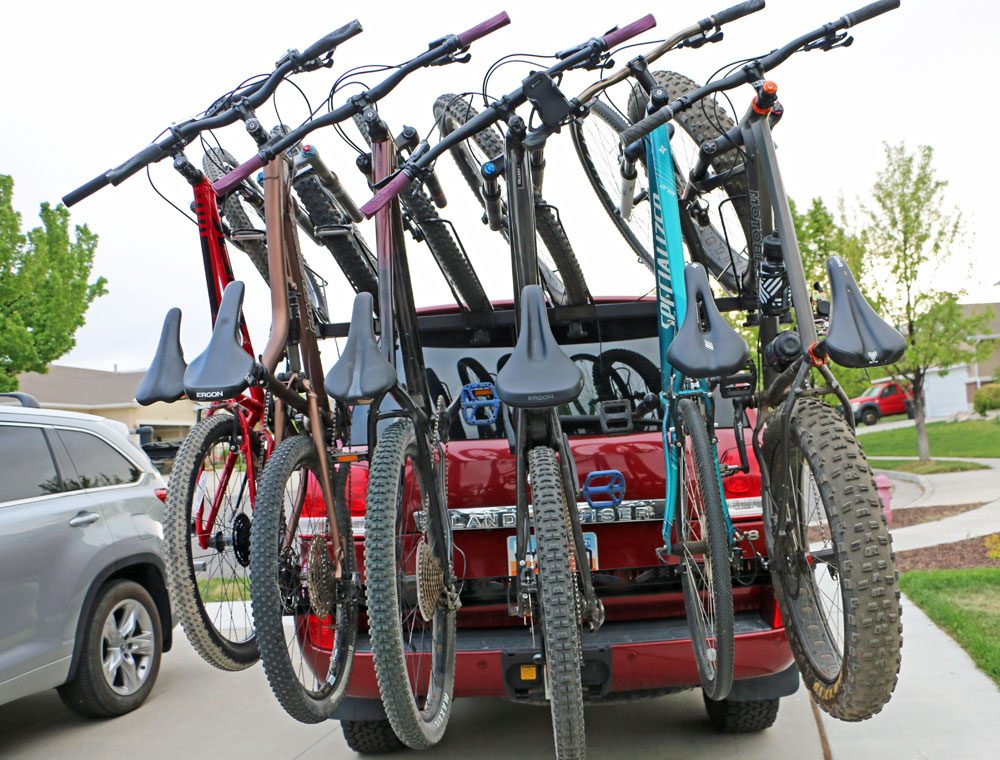
While the ability to slide the baskets from side to side was helpful in making adjustments on the Alta, we did find that the steeper tilt angle of the Velocirax’s hoops allowed for fewer contact issues. With the bike’s handlebars at a steeper angle, there was usually less contact between the shifter/brake levers of neighboring bikes on the Velocirax.
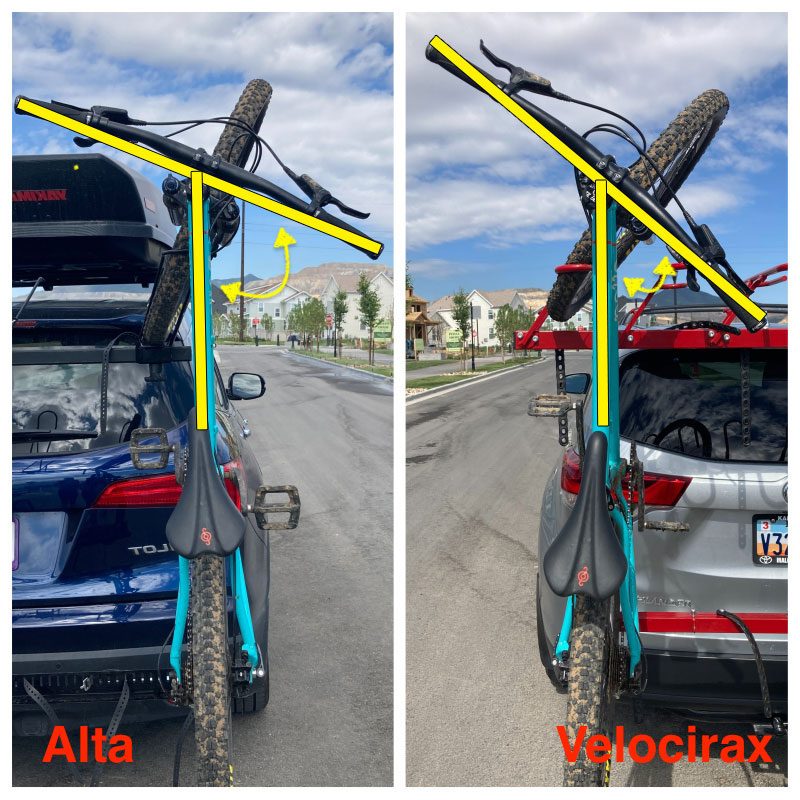
While we were almost always able to solve the spacing issues on the Alta, we found there were less likely to be spacing issues on the Velocirax. If we couldn’t solve the issues by rearranging bikes, as a last resort for both racks, we tilted the handlebars of the problematic bike while on the rack.
“No Lift” Loading
Both the Velocirax and the Alta require lifting to load the vast majority of bikes. The shorter the wheelbase of a bike and the taller the hitch height of the vehicle, the more lifting that will be required on both racks.
The shape of the Velocirax basket does require less lifting on some vehicles as it allows bikes to “roll” into the basket, which is a win for Velocirax. Loading bikes on the Alta does require you to lift the bike, but once placed over the basket, the front tire easily falls into place.
Swinging Bikes
Another difference we appreciated on the Alta Rack is how the bikes hang when being loaded. When loaded on the tilted Alta rack, the rear tires of all sizes of bikes rest against the lower bar of the rack. This prevents the bikes from swinging back and forth and easily allows you to see any need for adjustments before you strap the bikes down.
When loading bikes onto the Velocirax, the rear tire of some bikes (regardless of wheel size) can hang in front of the bottom bar, which can cause the rear tire to swing and come into contact with the bike next to it.

In addition to the potential for bikes to bump into each other, the swinging bikes make it challenging to spot spacing issues until after you strap the bikes down. Once strapped in, spacing issues can be spotted, which then requires you to unstrap the bikes, alter the order, and then restrap them in to recheck.
To prevent the bikes from swinging during loading, the Velocirax can be adjusted so that it doesn’t tilt down as far. (The Velocirax actually has two different tilt angle settings.) However, this higher tilt setting makes the wheel baskets higher, and thus a bit harder to reach when loading and unloading.
Wheel Straps
The straps that secure the front and rear wheels of the Alta and Velocirax are quite different and worth pointing out. Alta uses the well-known Voile rubber straps (on left), while Velocirax uses its own unique thick rubber strap (on right).

Both straps work great and which is “best” really comes down to personal preference. I found the Voile straps on the Alta were required less effort to lock into place, while other testers preferred the no-fuss, no-adjustment straps of the Velocirax.
The Voile straps on the Alta, however, can easily be replaced by any Voile strap and can also be used in a pinch to strap an extra tube or water bottle to your bike’s frame.
Carrying Various Size Bikes
Both racks excel at carrying modern 27.5″ and 29″ mountain bikes. On either rack, loading 6 or 7 mountain bikes that are similar in design is quick and easy and you shouldn’t anticipate a lot, if any, spacing problems. Problems with spacing usually only arise when attempting to load different sizes or styles of bikes. How the two racks deal with these different styles is another major differentiator.
24″ and 26″ Bikes
The standard hoop of the Velocirax fits 24″ and 26″ bikes with no adjustments needed. The standard Alta basket fits 24″ and 26″ wheels, but Alta recommends using a basket “choke” ($17) in order to provide more support for the smaller wheels. The choke consists of two metal bars with cutouts for the metal rim of the basket.

The choke is mounted onto the rear portion of the basket, helping to center the wheel in the basket. By being centered, both sides of the wheel are properly supported while on the rack.

16″ and 20″ Bikes
Both brands sell a small wheel basket designed to fit 20″ kids bikes and both did a great job hauling bikes without any contact between the rack’s baskets and the fork or frame of the bike. Using a pool noodle to pad the 20″ baskets, we were also able to fit a 16″ on both racks.
Due to the short wheelbases of 16″ bikes, the rear wheel of the 16″ bikes weren’t able to contact the bottom rack bar, which made for a less than ideal fit. So while this hack works for shorter distances, we wouldn’t recommend it for longer drives.

Also keep in mind, that with both racks, the more varied of sizes and styles of bikes you plan on carrying, the higher the likelihood you are going to have spacing issues between the bikes.
To fit a 16″ on the Alta, we found that wrapping a cut pool noodle (or tubing insulation) around the entire end of the basket was necessary. This prevented the basket from coming into contact with the front brake and fork. We highly recommend tapping the foam in place, as it is easy for it to shimmy its way out.

ebikes
Due to their additional weight as well as where the weight is located on the bike, ebikes can change the weight dynamics on the rack. With an ebike hanging on the rack, the heavy frame, motor, and battery (best to transport without the battery if you can), are positioned a foot or so away from the main mast of the rack, which can work to “pull” back and down on the rack, thereby pulling the rack farther away from the car.
To greatly reduce the leverage heavy ebikes have on the rack, Alta created an ebike strap ($10 per bike). The strap runs from the top horizontal bar to the crank arm/pedal of the ebike. Once connected and properly tightened, the strap pulls up on the pedal, which slightly lifts the ebike and moves the bike’s front wheel an inch or two closer to the car.
With the bike more forward on the rack, more of the bike’s weight can be centered directly over the top bar versus out at an angle, away from the rack.

Road Bikes and Gravel Bikes
Not surprisingly, gravel and road bikes with drop handlebars don’t fit as tightly on the rack as bikes with flat bars. The adjustable spacing on the Alta 4, 5 and 6 racks allows space for 4 bikes with drop handlebars, while the spacing of the Velocirax’s requires you to have their 7-capacity rack in order to fit 4 bikes with drop bars.
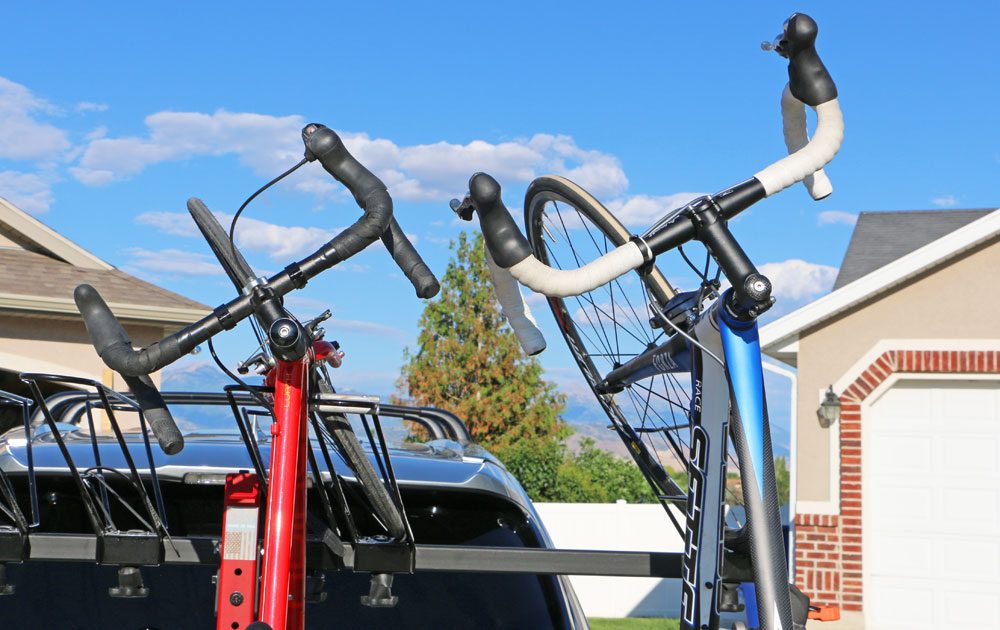
Odd Size Bikes
The adjustability of the Alta allows for a mix of odd-shaped bikes. In the image below, a single-wheeled trailer bike is loaded up on the rack. The team at Alta has also made their racks work for a 20″ recumbent mountain bike!

Tilting Racks with and without a Dampener System
The ability to tilt the racks to aid in loading and unloading bikes is one of the main differentiators between Alta and Velocirax versus other vertical rack designs. Both racks can actually be loaded and unloaded without tilting the rack down, but the tilting feature makes both processes much easier.
Velocirax’s Dampener Lowering System
One of Velocirax’s unique features is its dampening system. The dampening system is designed to help gently and slowly lower a loaded rack from the upright to the tilted position. The system works beautifully as the bikes on the Velocirax do indeed slowly tilt down without any human assistance.

With the Alta rack, there is no dampener to slow the bikes’ descent, so if you don’t support them, they will come down extremely fast (so make sure everyone is out of the way)! With the Alta, we found it is best to support the rack with your hand via one of the baskets or via the main mast from behind as it lowers.
If the rack does come crashing down, not to worry, the rack does has a rubber stopper to prevent any damage to the bikes or the rack.

There is an issue with Velocirax’s dampener that comes into play when you need to lower the rack while empty. With no weight on the rack, the dampeners keep the rack upright even after the release is pulled. As a result, you must pull down on the rack lower it. This process does take some effort and requires patience to wait for it to slowly tilt down.
On the Alta, lowering when empty is very quick and easy. As soon as you remove the outer safety pin, simply turn the lever and lower the rack down with one hand.
Pushing Bikes Back Up
Both the Alta and Velocirax are challenging to push up when fully loaded, but with the same bikes loaded onto each rack, the Alta is noticeably easier to push up. While there are several factors at play, after extensive testing, we found that the “heaviness” of the Velocirax was likely due to its lower tilt angle.
In its standard “lowest” tilt setting, the Velocirax tilts down lower than the Alta. As a result, on a tilted Velocirax, the bikes are positioned slightly lower to the ground (as compared to the Alta) and therefore require more force to push the bikes and rack upright.
The individual baskets of the Velocirax are also heavier than Alta’s. On a 6-capacity rack with standard baskets mounted on both, the baskets on the Velocirax weigh just over 10 pounds more than the baskets on the Alta.
Realistically, it is rare that one would ever be alone when hauling 6 bikes, so with both racks, there is usually always someone nearby to help you push the bikes back up if needed.
Arm Position and Hitch Stabilizer
The hitch designs of the Velocirax and Alta are very different. With both racks, we found the hitch receiver of the car to be the greatest determining factor of overall stability. The Alta fit like glove on our Highlander with a Curt hitch receiver, and the Land Cruiser stock receiver, while it was slightly less stable on the Pilot with its OEM Honda receiver. The Velocirax didn’t have any issues with any of the cars.
The Velocirax has an internal anti-wobble system, while the Alta has an internal and external stabilization system (external sold separately for $35).
The anti-wobble system of the Velocirax has a wedge inside the hitch arm which expands to fill in any gaps between the hitch arm and the receiver. Tightening the system is easy with a wrench at the base of the rack. The hitch pin is also locking, but it is just a pin, so it doesn’t screw into the receiver to help with stability.

The Alta’s “internal stabilization system” is simply a threaded hitch bolt. To provide flexibility in how close the rack is positioned to the car, Alta’s mounting arm has three mounting locations. Your car’s receiver, as well as its bumper design, can prevent the rack from being able to be installed in all three positions on some cars. On our Toyota Highlander and Honda Pilot test cars, the rack was installed with the hitch pin going through the middle position.

When properly tightened, on most receivers, the rack is held firm, but on loose receivers, Alta’s “external stabilization system” is recommended. The external system consists of a metal band, a metal plate, and a bolt. The plate is placed over the hitch arm, which allows the bolt on the metal plate to be tightened up against the receiver to further stabilize the rack. It’s not high-tech or pretty, but it works!

Unlike the Velocirax, the Alta does not have a built-in locking mechanism. We’ve never bothered to do so, but a cable lock or chain could be used to lock the rack to the receiver.
Locking Bikes on Vertical Racks
Unlike some platform racks, vertical racks do not have built-in locks for individual bikes, but Velocirax does now offer a built-in cable lock for the entire rack. The cable extends out of the top bar and can then be fed through the bikes.

To lock bikes on the Alta, you will need to use a cable lock as well. The rack has a loop on the main mast where you can put through the cable lock or even a U lock.

Weight Capacity
The Alta 4, 5, and 6 capacity racks have a total weight capacity of 300 lb. with a 50 lb. max per wheel basket. Alta does not, however, recommend carrying more than two ebikes on their rack. The Alta Superior, however, has a 350 lb. weight capacity and when the ebike straps are used, it can hold as many ebikes as you’d like under the 350 lb. limit (60 lb. weight limit per bike).
The North Shore 6 capacity also has a max weight of 300 lb., but their 4 capacity rack has a 200 lb. limit. The Velocirax 6 capacity has a total capacity of 230 lb.
Additional Benefits of Vertical Racks
Now that we’ve covered all the differences between the Alta and the Velocirax, we’ll now dive into the similarities. In this section, we’ll focus more on the benefits of vertical racks in general as compared to platform racks.
Higher Bike Capacity
Vertical racks can hold up to 6 or 7 bikes, while platform racks max out at 4. Whether you plan on shuttling your crew or your own family’s bikes to the trailhead, bike capacity is king. After testing both styles of racks, we found that the benefits of vertical racks go beyond just capacity.
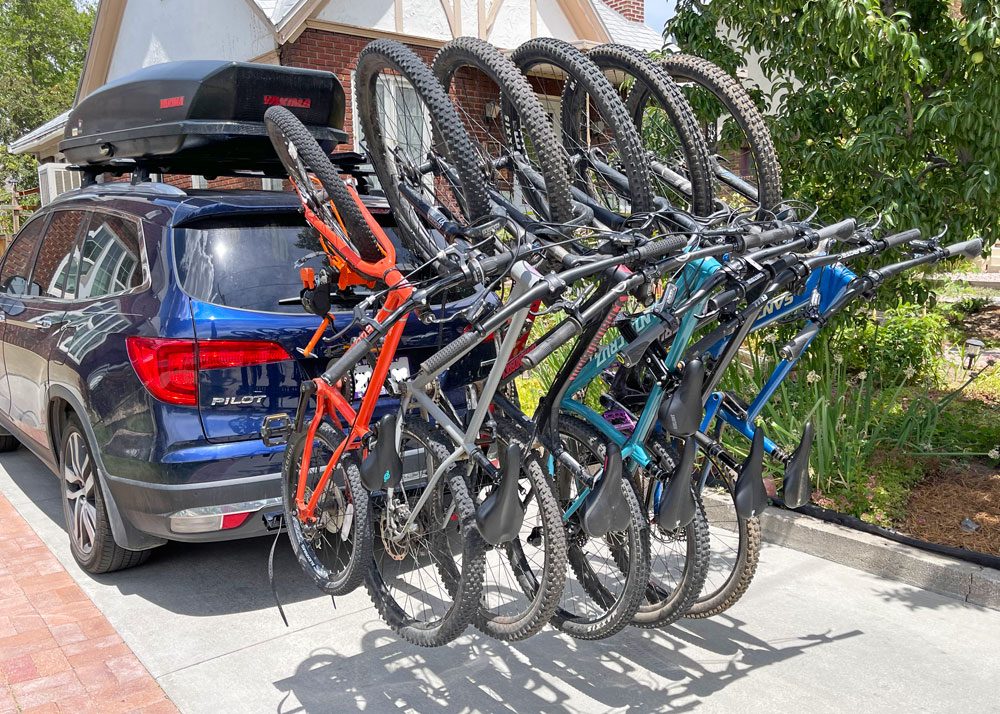
Driver Visibility
When folded up, larger capacity platform racks typically block the rear window of the car, which can greatly limit the visibility of the driver. With vertical racks, only the main mast and the top bar on some cars inhibit the view.

Visible Taillights and Turn Signals
Platform racks position bikes horizontally on the car, often in line with a car’s rear light panel. As a result, the brake lights, taillights, and turn signals on the car can be very difficult to see by the cars behind you. On a vertical rack, the rear lights of a car are much more visible through the bikes than on a platform rack.

Platform racks can also block the rear lights when folded up for storage on a car, while vertical racks do so minimally.
Less issues with spacing
Vertical racks typically provide much more space between bikes when loaded. Platform racks often have issues with handlebars hitting saddles and pedals hitting frames, but for the most part, spacing issues are minimized on vertical racks (but not completely prevented).
Tilt Down for Easier Loading and Rear Access
Alta and Velocirax tilt back to lower the baskets to make loading and unloading bikes easier. The tilt-down feature also allows for easier access to the back of the car.
Even with a fully loaded rack, the rear hatch of most cars will open when the racks are tilted back. Lolo and Yakima HangTight both tilt down to allow access when the rack is unloaded, but not when loaded or to help hang the bikes.
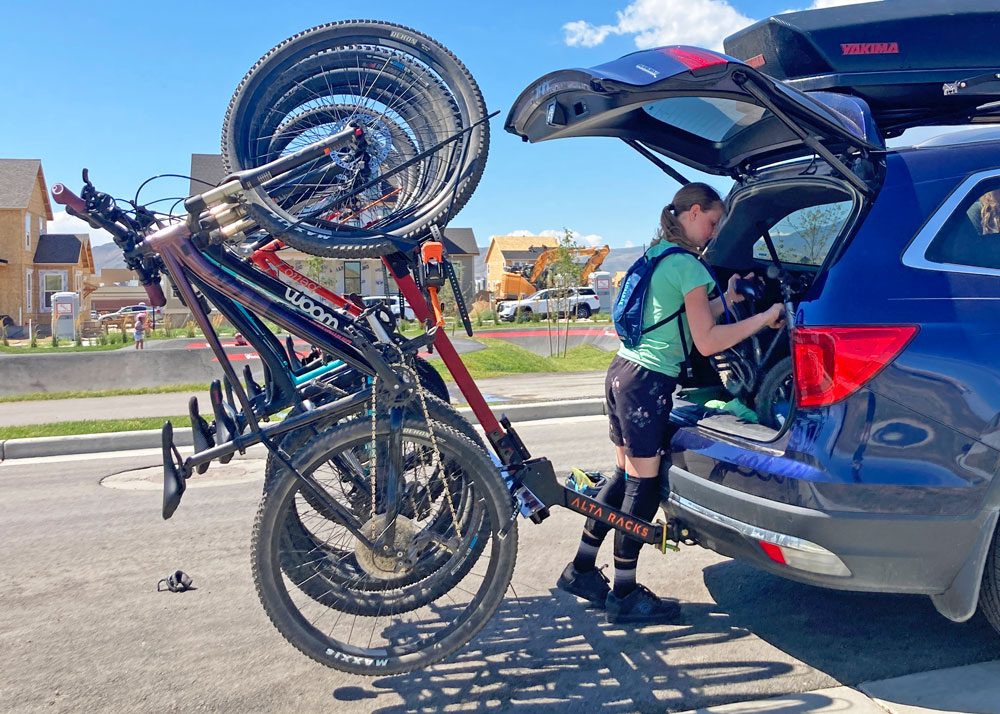
Vertical bike racks also tend to allow for more room between the rack and the rear bumper. This extra space makes it much easier to haul things in and out of the back of the car as compared to a platform rack whether the rack is loaded or unloaded.
Alta Rack Swing Out Arm (Swinger) Review
Working hard to keep its title as the Swiss Army Knife of bike racks, Alta recently added a swing out arm (called the Swinger) to its line of optional upgrades. The Swinger allows you to pull the rack away from your car’s bumper (fully loaded or empty) to grant easy access to the tailgate.
Everything from post-ride lunches to loading gear is significantly made easier with the rack swung open. This is especially true if you have a van with bi-fold doors or a swing out spare tire on your tailgate (as shown on our Land Cruiser below).

Considering how easy and convenient the Swinger is to use, if you have it in your budget, we would absolutely recommend adding the Swinger to your rack order, but it doesn’t come cheap. As on April 2024, if you order the Swinger arm with your initial rack order, it will cost an additional $950. If you order the Swinger to add onto a rack you already own, it will run you $1,150 (difference in price due to difference in rack hitch arm explained below).
Yes, the Swinger is expensive, but there is a reason no other high-capacity rack offers a swing out arm. Engineering a swing out that will also securely handle 350 lb. of bikes on top of it took years of testing and precision engineering.
The closest swing-out option on the market to Alta’s is the RakAttach, but its max weight capacity is 275 lb., which doesn’t include the weight of the rack! Considering a 6-capacity VelociRAX weighs 98 lb., when used with a RakAttach, your weight limit would be down to 177 lb., which would greatly limit the type of bikes you could carry. The Alta Swinger’s weight capacity is 350 lb.

How does the Alta Swing-out Arm work?
The Swinger works via a heavily-engineered pivoting arm that allows the rack to extend away from the vehicle’s hitch. Once open, the swing-out can be locked open by a robust red metal pin that easily slides into place (red arrow pointing to it below). The Swinger can be configured to swing out to either side of the vehicle, but can’t be done on the fly and takes some modifications to switch it.

When closed, the Swinger is held tight to the hitch via a metal clamp. The metal clamp is secured closed with a safety ring as well as the same red metal pin used to keep the rack locked in open position.

The Swinger is designed specifically to work with Alta racks and will not work with any other brand of racks. In fact, due to the precise engineering required to minimize flexing and ensure stability, the entire hitch arm on existing Alta racks must be replaced in order to use the Swinger. If you order the Swinger for an existing rack, it does come with the new hitch arm (which is why the listing says “with short hitch”).
Does the closed Swinger extend the rack farther back from the car than the standard Alta?
The Swinger DOES NOT extend the rack farther past your hitch receiver than a standard Alta rack. So if you park your car in the garage with the Alta installed, you don’t have to plan for additional space behind the rack once the Swinger is installed.
The pivoting arm of the Swinger is specifically designed to take up the same distance between your hitch and the rack’s hitch arm as a standard Alta. This is one of the reason why the Swinger comes with a new hitch arm when ordered for existing racks.
Will the Alta rack I already have work with the swing out?
Yes! In order to help stabilize the swing out, as well as prevent the rack from extending further out from your car, installing a Swinger kit on an existing rack will require you to swap out the hitch arm of your Alta. The Swinger will come with a new hitch arm (included in the price) and once you have the tools necessary, it can be done in about 20 minutes.
Since the Swinger requires a new hitch arm, the Swinger costs $200 more to purchase for an existing rack than it does if you were to order with a new rack. (New racks come with the Swinger hitch arm already installed).
Alta Racks Vertical Bike Rack Bottom Line
Whether you have a vehicle with a low hitch or a high hitch, the Alta rack is a breeze to use. Offering the most adjustability of all vertical racks, the ability to confidently carry 20″ bikes, as well as an industry-leading warranty and weight capacity, the Alta Rack is an ideal rack for active families as well as adult riders.
Easy to use while loaded, as well as the 95% of the time it is unloaded while on your car, an Alta Rack is sure to keep your family or your riding crew happily riding for years to come.
QUICK REMINDER: If this review helped you out and you decide to purchase an Alta Rack, we would greatly appreciate it if you added our name “Two Wheeling Tots” in the notes section at checkout. We are not an affiliate of Alta, but it would help us continue to share the love of Alta with others.
FTC Disclosure: Affiliate links are not included in this review. No monetary compensation was provided for this review. All opinions and images are that of Two Wheeling Tots LLC. All content and images are copyrighted and should not be used or A replicated in any way. View our Terms of Use.
